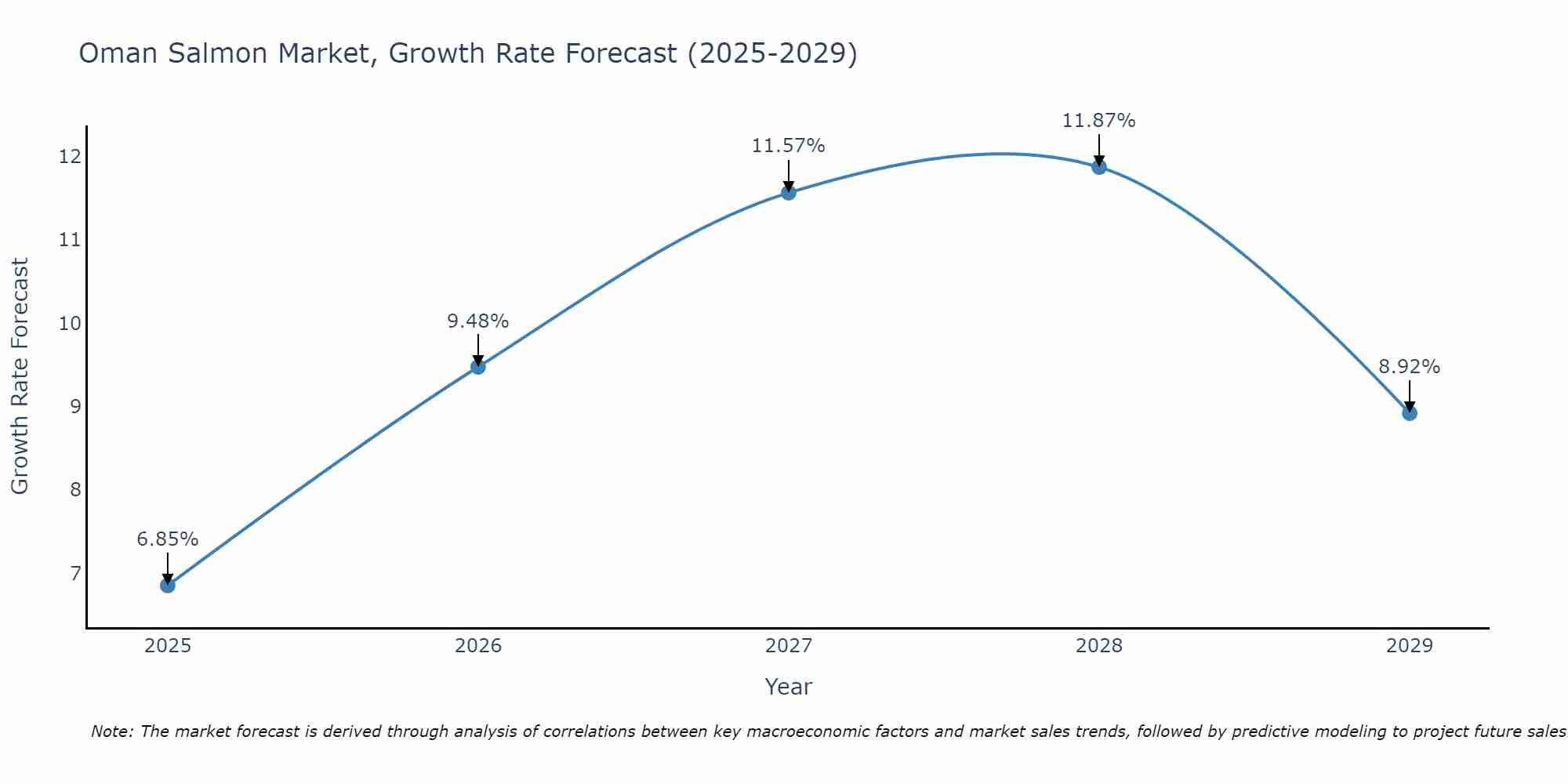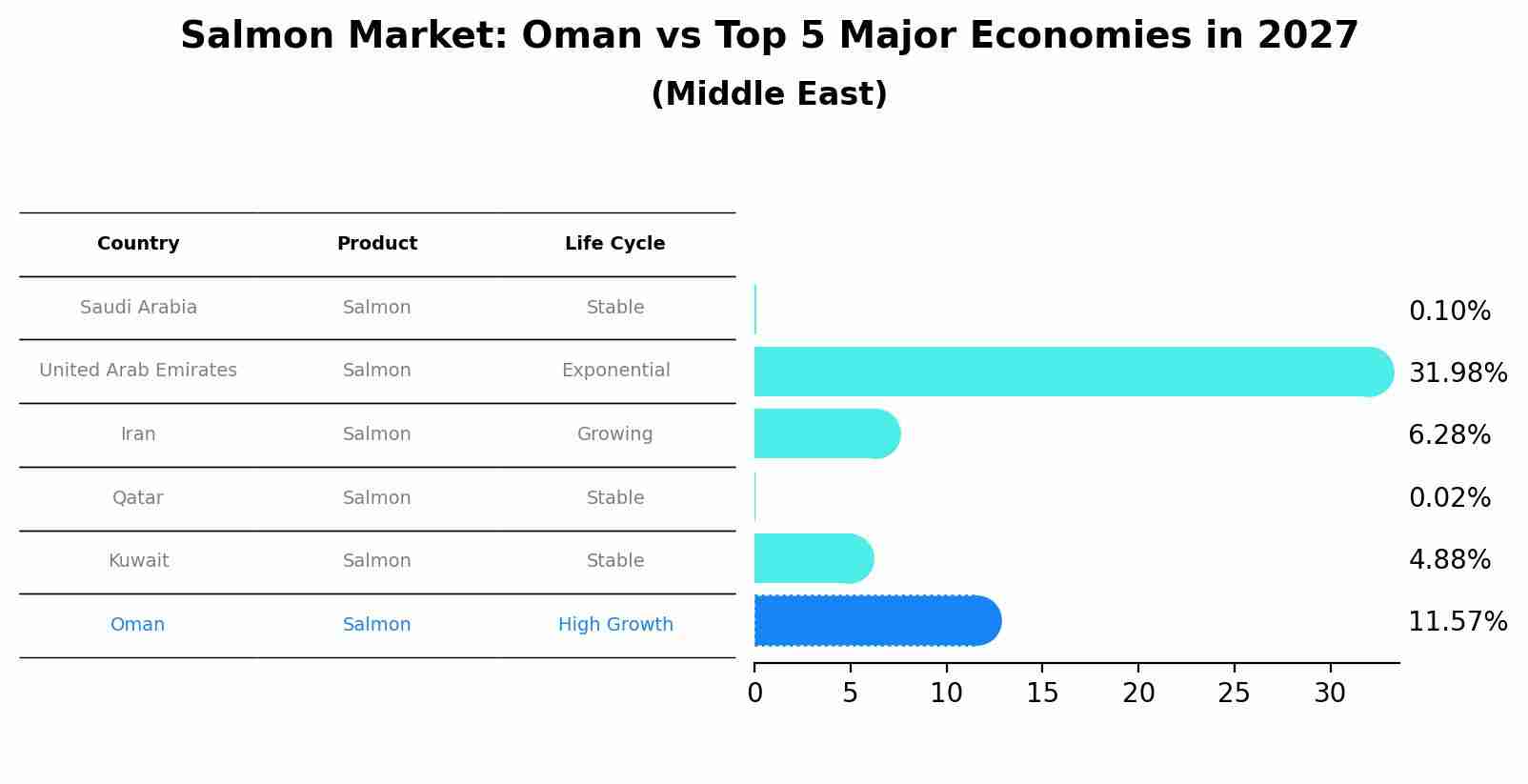Oman Salmon Market (2025-2031) Outlook | Growth, Analysis, Size, Industry, Value, Share, Companies, Trends, Forecast & Revenue
| Product Code: ETC387643 | Publication Date: Aug 2022 | Updated Date: Jul 2025 | Product Type: Market Research Report | |
| Publisher: 6Wresearch | Author: Vasudha | No. of Pages: 75 | No. of Figures: 35 | No. of Tables: 20 |
Oman Salmon Market Size Growth Rate
The Oman Salmon Market is projected to witness mixed growth rate patterns during 2025 to 2029. Growth accelerates to 11.87% in 2028, following an initial rate of 6.85%, before easing to 8.92% at the end of the period.

Salmon Market: Oman vs Top 5 Major Economies in 2027 (Middle East)
By 2027, the Salmon market in Oman is anticipated to reach a growth rate of 11.57%, as part of an increasingly competitive Middle East region, where Saudi Arabia remains at the forefront, supported by United Arab Emirates, Iran, Qatar and Kuwait, driving innovations and market adoption across sectors.

Oman Salmon Market Synopsis
The Oman Salmon Market is a niche but growing segment within the country`s seafood industry. With a focus on high-quality and fresh seafood products, salmon has gained popularity among consumers looking for healthy and premium options. The market is driven by increasing awareness of the health benefits of consuming salmon, such as being rich in omega-3 fatty acids. Additionally, the growing trend of international cuisine and fine dining in Oman has contributed to the rising demand for salmon. Major players in the Oman Salmon Market include seafood importers, distributors, and retailers who cater to both the local population and expatriates. As the market continues to evolve, there is potential for further growth and diversification in product offerings to meet the changing preferences of consumers.
Oman Salmon Market Trends
The Oman Salmon market is experiencing growth driven by increasing consumer demand for healthy and high-quality seafood products. There is a rising trend towards sustainable and environmentally friendly salmon farming practices, with a focus on reducing the carbon footprint of the industry. Additionally, the popularity of salmon as a versatile and nutritious protein source has led to a wider range of salmon products being introduced in the market, catering to different consumer preferences. The market is also seeing a shift towards online retail channels for salmon purchases, offering convenience and a wider selection of products to consumers. Overall, the Oman Salmon market is expected to continue its growth trajectory, fueled by these key trends in sustainability, product innovation, and digitalization.
Oman Salmon Market Challenges
In the Oman Salmon Market, one of the main challenges faced is the reliance on imports to meet domestic demand. This leads to issues such as high transportation costs, potential supply chain disruptions, and vulnerability to fluctuations in international markets. Additionally, the market may struggle with consumer preferences for fresh salmon over frozen varieties, which can impact pricing and availability. Another challenge is ensuring the quality and freshness of imported salmon, as delays in transportation or storage conditions can affect the product`s appeal to consumers. Furthermore, competition from other seafood products in Oman`s market presents a challenge in establishing salmon as a popular and widely consumed option among consumers. Overall, addressing these challenges will require strategic planning, investment in infrastructure, and efforts to educate and attract consumers to the benefits of salmon consumption.
Oman Salmon Market Investment Opportunities
The Oman Salmon Market presents promising investment opportunities due to increasing consumer demand for high-quality seafood products in the region. With a growing awareness of the health benefits associated with salmon consumption, there is a rising trend towards incorporating salmon into diets. Investing in salmon aquaculture operations in Oman could be lucrative, as the country`s favorable environmental conditions, such as clean waters and suitable temperatures, provide an ideal setting for salmon farming. Additionally, Oman`s strategic location offers access to key markets in the Middle East and beyond, enhancing the export potential of salmon products. By capitalizing on these factors and implementing sustainable practices, investors can tap into the growing market for premium salmon products in Oman and capitalize on the increasing demand for seafood in the region.
Jordan Agar Market Government Policies
In Oman, the government has implemented policies to support the development of the salmon market. This includes initiatives to promote sustainable aquaculture practices, improve fish farming techniques, and enhance food safety standards. The government has also focused on increasing domestic production of salmon to reduce reliance on imports and boost the local economy. Additionally, regulations are in place to ensure the quality and safety of salmon products in the market, with strict monitoring and enforcement mechanisms in place. Overall, the government`s policies aim to drive growth in the salmon market, create employment opportunities, and enhance food security in Oman.
Oman Salmon Market Future Outlook
The future outlook for the Oman Salmon Market appears promising, driven by increasing consumer demand for healthy and high-quality seafood products. With a growing awareness of the nutritional benefits of salmon, as well as an emphasis on sustainable and environmentally friendly practices in the fishing industry, Oman is well-positioned to capitalize on this trend. Additionally, advancements in aquaculture technology and practices are likely to enhance production efficiency and quality control in the salmon market. As a result, we can expect to see continued growth and innovation in the Oman Salmon Market, with opportunities for both domestic consumption and export to international markets. However, challenges such as competition from other salmon-producing regions and fluctuating market prices may also impact the market dynamics in the future.
Key Highlights of the Report:
- Oman Salmon Market Outlook
- Market Size of Oman Salmon Market, 2024
- Forecast of Oman Salmon Market, 2031
- Historical Data and Forecast of Oman Salmon Revenues & Volume for the Period 2021 - 2031
- Oman Salmon Market Trend Evolution
- Oman Salmon Market Drivers and Challenges
- Oman Salmon Price Trends
- Oman Salmon Porter's Five Forces
- Oman Salmon Industry Life Cycle
- Historical Data and Forecast of Oman Salmon Market Revenues & Volume By Type for the Period 2021 - 2031
- Historical Data and Forecast of Oman Salmon Market Revenues & Volume By Chinook Salmon for the Period 2021 - 2031
- Historical Data and Forecast of Oman Salmon Market Revenues & Volume By Coho Salmon for the Period 2021 - 2031
- Historical Data and Forecast of Oman Salmon Market Revenues & Volume By Pink Salmon for the Period 2021 - 2031
- Historical Data and Forecast of Oman Salmon Market Revenues & Volume By Red Salmon for the Period 2021 - 2031
- Historical Data and Forecast of Oman Salmon Market Revenues & Volume By Salmo Salar for the Period 2021 - 2031
- Historical Data and Forecast of Oman Salmon Market Revenues & Volume By Silverbrite Salmon for the Period 2021 - 2031
- Historical Data and Forecast of Oman Salmon Market Revenues & Volume By End Product Type for the Period 2021 - 2031
- Historical Data and Forecast of Oman Salmon Market Revenues & Volume By Fresh for the Period 2021 - 2031
- Historical Data and Forecast of Oman Salmon Market Revenues & Volume By Frozen for the Period 2021 - 2031
- Historical Data and Forecast of Oman Salmon Market Revenues & Volume By Canned for the Period 2021 - 2031
- Historical Data and Forecast of Oman Salmon Market Revenues & Volume By Others for the Period 2021 - 2031
- Historical Data and Forecast of Oman Salmon Market Revenues & Volume By Distribution Channel for the Period 2021 - 2031
- Historical Data and Forecast of Oman Salmon Market Revenues & Volume By Retail Stores for the Period 2021 - 2031
- Historical Data and Forecast of Oman Salmon Market Revenues & Volume By Hypermarket/supermarket for the Period 2021 - 2031
- Historical Data and Forecast of Oman Salmon Market Revenues & Volume By Online Sales Channels for the Period 2021 - 2031
- Oman Salmon Import Export Trade Statistics
- Market Opportunity Assessment By Type
- Market Opportunity Assessment By End Product Type
- Market Opportunity Assessment By Distribution Channel
- Oman Salmon Top Companies Market Share
- Oman Salmon Competitive Benchmarking By Technical and Operational Parameters
- Oman Salmon Company Profiles
- Oman Salmon Key Strategic Recommendations
Frequently Asked Questions About the Market Study (FAQs):
- Single User License$ 1,995
- Department License$ 2,400
- Site License$ 3,120
- Global License$ 3,795
Search
Thought Leadership and Analyst Meet
Our Clients
Related Reports
- Canada Oil and Gas Market (2026-2032) | Share, Segmentation, Value, Industry, Trends, Forecast, Analysis, Size & Revenue, Growth, Competitive Landscape, Outlook, Companies
- Germany Breakfast Food Market (2026-2032) | Industry, Share, Growth, Size, Companies, Value, Analysis, Revenue, Trends, Forecast & Outlook
- Australia Briquette Market (2025-2031) | Growth, Size, Revenue, Forecast, Analysis, Trends, Value, Share, Industry & Companies
- Vietnam System Integrator Market (2025-2031) | Size, Companies, Analysis, Industry, Value, Forecast, Growth, Trends, Revenue & Share
- ASEAN and Thailand Brain Health Supplements Market (2025-2031) | Strategy, Consumer Insights, Analysis, Investment Trends, Opportunities, Growth, Size, Share, Industry, Revenue, Segments, Value, Segmentation, Supply, Forecast, Restraints, Outlook, Competition, Drivers, Trends, Demand, Pricing Analysis, Competitive, Strategic Insights, Companies, Challenges
- ASEAN Bearings Market (2025-2031) | Strategy, Consumer Insights, Analysis, Investment Trends, Opportunities, Growth, Size, Share, Industry, Revenue, Segments, Value, Segmentation, Supply, Forecast, Restraints, Outlook, Competition, Drivers, Trends, Demand, Pricing Analysis, Competitive, Strategic Insights, Companies, Challenges
- Europe Flooring Market (2025-2031) | Outlook, Share, Industry, Trends, Forecast, Companies, Revenue, Size, Analysis, Growth & Value
- Saudi Arabia Manlift Market (2025-2031) | Outlook, Size, Growth, Trends, Companies, Industry, Revenue, Value, Share, Forecast & Analysis
- Uganda Excavator, Crane, and Wheel Loaders Market (2025-2031) | Strategy, Consumer Insights, Analysis, Investment Trends, Opportunities, Growth, Size, Share, Industry, Revenue, Segments, Value, Segmentation, Supply, Forecast, Restraints, Outlook, Competition, Drivers, Trends, Demand, Pricing Analysis, Competitive, Strategic Insights, Companies, Challenges
- Rwanda Excavator, Crane, and Wheel Loaders Market (2025-2031) | Strategy, Consumer Insights, Analysis, Investment Trends, Opportunities, Growth, Size, Share, Industry, Revenue, Segments, Value, Segmentation, Supply, Forecast, Restraints, Outlook, Competition, Drivers, Trends, Demand, Pricing Analysis, Competitive, Strategic Insights, Companies, Challenges
Industry Events and Analyst Meet
Whitepaper
- Middle East & Africa Commercial Security Market Click here to view more.
- Middle East & Africa Fire Safety Systems & Equipment Market Click here to view more.
- GCC Drone Market Click here to view more.
- Middle East Lighting Fixture Market Click here to view more.
- GCC Physical & Perimeter Security Market Click here to view more.
6WResearch In News
- Doha a strategic location for EV manufacturing hub: IPA Qatar
- Demand for luxury TVs surging in the GCC, says Samsung
- Empowering Growth: The Thriving Journey of Bangladesh’s Cable Industry
- Demand for luxury TVs surging in the GCC, says Samsung
- Video call with a traditional healer? Once unthinkable, it’s now common in South Africa
- Intelligent Buildings To Smooth GCC’s Path To Net Zero


















